Khiam Prison
Israel´s Torture Den
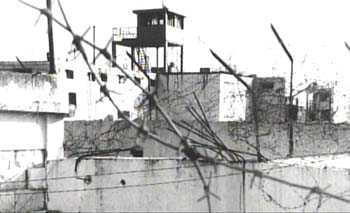
Khiam prison was a detention and interrogation camp during the
years of the Israeli occupation in Southern Lebanon. From 1985 until
the Israeli defeat in May 2000, thousands of Lebanese were held in
Khiam without trial. Most of them were brutally tortured - some of
them died.
The prisoners included members of the resistance, their relatives,
civilians by the dozen whose crime was innocence, who would not
collaborate with the Israelis or the SLA, who refused to join the
murderous little militia, who declined to give the Israelis
information about the Lebanese resistance.
Israel ran the prison using the militia they had created from the
Maronite Christian community - the SLA. The SLA provided Khiams
guards and interrogators whilst israelis held the top positions.
They provided the training for the torturers and lead the torture
sessions. They paid the salaries and provided all the equipment.
They commanded, the SLA followed.
Men women and even several children were locked up without trail,
some spent decades here.
Children Tortured
Ali Kashmar was fourteen when he became caught up in the conflict
that was to cost him his youth. Ali was simply a schoolboy.
"I was like everyone else; all I could think about was playing. At
that stage if I thought about the future at all it was about passing
my exams and waiting for the results of my studies."
This picture was taken just two weeks before Ali disappeared from
his family's life.
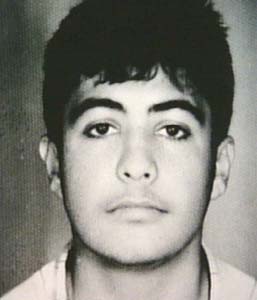
Ali Kashmar, aged 14, was imprisoned
& tortured at Khiam |
No one really seems to know why he was arrested. He thinks it may
have been because he made anti-Israeli remarks in the school
playground.
It happened the night he'd chosen to sleep alone for the first time.
"I thought that that night I'd become a man. I was asleep when
suddenly I had guns pointed at me and my mother and sister were
crying."
There were armed men everywhere - outside the windows, in the street
and on the roof.
Ali Kashmar's Mother Sobiyeh:
"He got to the front door, hugged me and said goodbye Mother. I
collapsed against the wall. After a while I looked around and he was
gone. I ran outside and saw the cars speeding away."
It would be ten years before Ali was back here with his mother
Sobiyeh.
In prison:
"Alone I fought with time. I thought about my parents and my
friends. I got mange for five years because of a lack of
cleanliness, so I used to spend my time scraping my scabs waiting
for the time when they offered me food. I tried to sleep as much as
possible to make the time pass."
Ali Kashmar was now seven years into his detention.

Ali Kashma's mother Sobiyeh without her son for 10 years |
Each night his mother would lay an extra place at the table for her
missing son. And as she went about those daily rituals that bind a
family together, she was constantly reminded of the place that had
swallowed him up.
The Kashmar family home is in the town of Khiam and from her roof
she could see the prison.
"I used to take my cigarettes, go up to the roof and sit there. I
used to imagine I was talking to Ali. I'd say; 'my son, my beloved
son, what are you doing now, what are they doing to you, where have
they put you?' I'd think that I was talking to him and that he was
going to answer me. When the neighbours heard me they'd come to take
me down."
The interrogators were looking for intelligence about anti-Israeli
resistance operations. But after eleven days of torture in Khiam the
fourteen year old Ali Kashmar, with no real secrets to tell,
remembers desperately making things up.
"I tried to convince myself that I was someone important. I told
myself I must be stupid, I probably am involved, I've probably done
many things against them and worked for other people without being
aware of it. In the end I made up story after story after story.
Later my conscience started bothering me but I ignored it because I
just couldn't think straight anymore."
The interrogators forgot about Ali, once they realised he had
nothing to tell them. But there were no courts to rule on his guilt
or innocence, no one to appeal to for release. So Khiam kept Ali
anyway. Through his teens and into his twenties.
Freedom could be as arbitrary as detention. In 1998 in an exchange
between Israel and Lebanon, fifty-five Khiam prisoners were freed
and forty-four Lebanese corpses were handed over. The remains of
three Israeli soldiers were delivered in return.
After a decade Ali Kashmar had served his purpose - one of those
bargaining chips in this grim trade in the living and the dead.
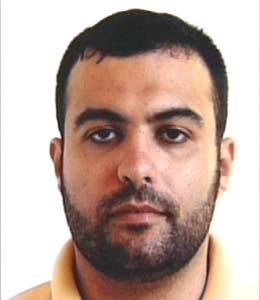
Ali Kashmar upon release after 10 year
of imprisonment without
charge.
Compare this photo taken upon his release
with the one aged 14 which
was taken just
before his arrest. The years in between were
lost at Khiam. |
Ali Kashmar's Mother on seeing Ali after years or imprisonment:
"I stared at him and said to myself; 'this man has a beard, in my
imagination my son was still a little boy'. I had never thought that
he was grown up and had become a man. I stared at him . I wanted to
say; 'why am I here, where's my son?' Then Ali said; 'Mother look at
me, Mother it's me, Ali'. And he laughed. When I saw his smile I
finally recognised him."
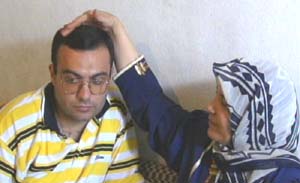
Mother and son reunited again after 10 years |
Ali Kashmar on his release:
"For a month I heard but nothing but horns and voices, horns and
traffic and cars. I tried to spend some time alone and sleep, to get
used to the outside world step by step."
"I wanted to go down the street in my pyjamas but my parents told me
this was an embarrassing thing to do. I couldn't understand why
because in prison I always wore pyjamas."
Ali Kashmar about his imprisonment:
"If a person is free he can look in a mirror and see his appearance
changing. In prison we had no means to look at ourselves. Once I saw
a mirror in the guard's room, someone was reflected in it, so I
looked back to see who it was. It turned out to be me. It was I
moving in that mirror."
"It's really hard to summarise all that period in seconds. But I
tell you something - when you die you die in a second but in that
prison you died a hundred times every day."
Methods Of Torture
Ryadh Kalekesh comes from a family that was deeply involved in
Hezbollah and its resistance against Israeli occupation - one of his
brothers had been martyred as a "suicide" bomber.
He didn't have time to play much of an active role in the fighting
himself. In the spring of 1986, when he was seventeen, Israeli
troops made a sweep through his village and he went into hiding.
"When they caught me they started beating me and asking for
information about saboteurs. I told them I didn't know any
saboteurs. I'd come here to visit my grandparents and didn't have
any weapons."
"I lost consciousness. They woke me up by beating me and throwing
water on my face then they made me stand up, my hands and feet
cuffed. They said; 'you will stay like this until we tell you to sit
down'. I was standing the whole time with no food or water. Every
fifteen minutes I'd start to collapse. This lasted for six or seven
hours, throughout that time they were interrogating and beating me."
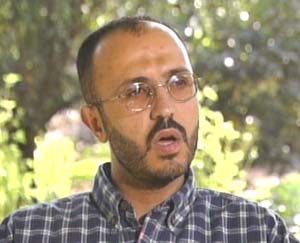
Ryadh Kalekesh - tortured |
In prison, Ryadh Kalekesh:
"I told the guard that I needed to go to the lavatory. He said; 'no,
urinate in your cell'. They gave us hardly any food, so a long time
passed before we defecated. I used to defecate once every fifteen or
twenty days. Many detainees were like me. As for urinating, I used
to urinate on the floor, I had no choice."
Most of the questioning was done in the interrogation rooms and the
process could last for months.
In evidence from the detainees the same stories keep coming up. Most
endured electric shocks administered by attaching wires to the
fingertips, the tongue or the genitals.
Ryadh Kalekesh:
"They electrocuted me, choosing a particularly sensitive place. I
used to lose consciousness and wake up to find myself stumbling
blindly in my room. During the interrogation the Israelis were there
all the time torturing me that way."
New prisoners quickly became familiar with what they called 'the
pole'. Hooded and handcuffed to the ironwork, often naked, they were
beaten, doused in hot then cold water or simply left to hang here
for hours with their toes just touching the ground.
Whole Families Tortured
Sometimes whole families would be drawn in. The Kalekesh's were a
natural target for attention. With one brother Ryadh detained in
Khiam and a second martyred in a "suicide" bomb attack, a third
brother, Adel, came home from abroad to join Hezbollah.
In 1993 Adel was arrested and taken to Khiam too. When he proved
tough under torture his wife was pulled in as well.
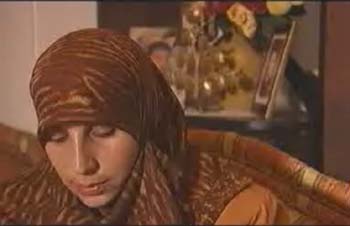
Mona, pregnant at the time, was subjected to utmost torture |
Three members of the same family were now within Khiam's walls. Mona
was pregnant with their first child at the time. Her interrogator
played her against her husband and her husband against her.
Mona recalls:
"They beat my husband and made me listen to him screaming. They also
made me listen to Ryadh scream while he was beaten. They used this
method for a while but they didn't get anything from me."
The women's section of the prison was smaller than the men's but
some of them were tortured just as badly.
"He beat me and attached the electrodes to my nipples. Then all I
remember is that I was screaming."
Mona spent a total of three months in solitary confinement. After
one day long interrogation she was taken to hospital. When she
returned after being patched up the torture resumed.
"He lay on the bed and started, I don't know how to tell this, he
started masturbating. At that moment I was really terrified. He
approached me while I was sitting on a chair and tried to rub his
body against me. That moment was the only one when I felt really
vulnerable. I felt that he was trying to take something from me.
Then I started crying."
Mona lost her baby in Khiam. Her husband Adel may never be able to
father another child because of the way he was tortured there.
The Tools Of Torture
Robert Fisk, a British journalist, describes what he saw at Khiam
during a visit days after its liberation:
The torturers had just left but the horror remained. There was the
whipping pole and the window grilles where prisoners were tied naked
for days, freezing water thrown over them at night. Then there were
the electric leads for the little dynamo - the machine mercifully
taken off to Israel by the interrogators - which had the inmates
shrieking with pain when the electrodes touched their fingers or
penises. And there were the handcuffs which an ex-prisoner handed to
me yesterday afternoon.
|

An ex-prisoner demonstrates how "the pole"
was used
|
Engraved into the steel were the words: "The Peerless Handcuff Co.
Springfield, Mass. Made in USA." And I wondered, in Israel's most
shameful prison, if the executives over in Springfield knew what
they were doing when they sold these manacles.
They were used over years to bind the arms of prisoners before
interrogation. And they wore them, day and night, as they were
kicked - kicked so badly in Sulieman Ramadan's case that they later
had to amputate his arm. Another prisoner was so badly beaten, he
lost the use of a leg. I found his crutch in Khiam prison yesterday,
along with piles of Red Cross letters from prisoners -- letters
which the guards from Israel's now-defunct "South Lebanon Army"
militia never bothered to forward.
"I was hung here naked for 13 days,"
Abdullah Attiyeh told me as we walked along a dirty passageway
beside the wall of the old French mandate fort.
"They put a bag on my head and threw cold water over me night and
day."
The hoods were still there, big light-blue corduroy sacks with
towels inside -- some of the towels bought from Norwegian Unifil
soldiers because the UN globe was embroidered on some of them -- and
so was the wire with which other prisoners, including women, were
beaten. Big, thick wire bound in blue plastic. The torturers were
sadistic, often stupid men. There were pornographic magazines and
cheap comics and puzzle books in their filthy quarters. Israel has
admitted teaching these men how to do their job.
Ibrahim Kalash was allowed a bath once every 40 days.
"If we spilt water on the floor, they used to make us lick it
clean," he said.
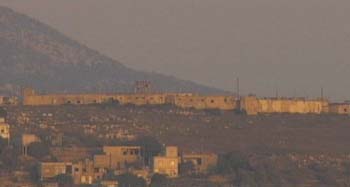
Khiam prison surrounded by minefields |
Abdullah Attiyeh was asked why they didn't escape:
"You're surprised we didn't escape? Four men did. One made it,
another was shot, another captured and the fourth blew himself up on
a mine and lost a leg and an eye."
Around the prison there are minefields galore.
"An Israeli officer came here and told the SLA men 'Destroy
everything that is green', That is why there are no trees, just long
grass with mines."
UN Stayed Silent
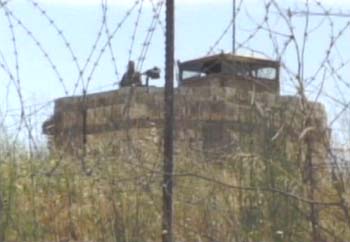
The screams of the prisoners being tortured could be
heard from the UN post |
Khiam wasn't entirely isolated from the outside world. From the
prison yard you can see the blue flag of the United Nations snapping
in the Mediterranean breeze.
There was a UN post within sight and hearing of Khiam throughout its
time as a detention and interrogation centre.
But they did nothing - "the UN contingent here are supposed to be
observing Lebanon's border with Israel, it's not part of the mandate
to act on whatever may or may not have seen or heard beyond the
prison walls."
Confessions Of A Prison Guard
Tanios Nahra was a guard at Khiam from 1985 until 1987 - years which
saw some of the worst excesses.

Tanios Nahra, Khiam
Prison Guard |
Tanios Nahra:
"There was this old field telephone they used to wind manually, the
wires were tied to the detainee's fingers and could produce as much
power as your mains at home. If you crank it quickly the detainee
might lose consciousness so it's better to crank it slowly - that
way the detainee suffers more."
Do you remember seeing Israeli officers present while electric shock
treatment was being administered or while people were on the pole?
"They weren't just present; they themselves hung people on the pole
and electrocuted them. The Lebanese interrogators imitated the
Israelis because they were in charge. The Israelis were present less
often but as for torture they were even worse."
Confessions Of A Nurse
When prisoners did get medical attention, they were brought to the
Israeli run Marjayoun Hospital.
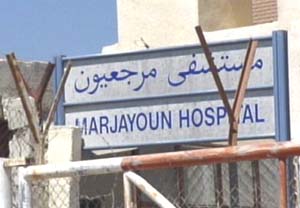
Marjayoun Hospital where tortured prisoners
were sometimes brought |
None of the staff would talk openly about what they saw when
prisoners were brought in. One nurse did agree to speak if her
identy was concealed.
Nurse:
"They were brought here with bags on their heads, even if they had
asthma. They would be dragged in here hooded and handcuffed. The
guard would torture them. When prisoners rang he would verbally
abuse them and beat them. Then he'd lock the door and wouldn't let
anyone come in. The guard sometimes used to stub his cigarettes out
on the patients."
The medical files at Marjayoun Hospital provide one of the very few
sources of written evidence about what happened at Khiam prison. The
prisoners are listed not by their family names but by their prison
numbers and these paint a pretty grim picture of the condition some
of them were in when they were brought here. The diagnoses include
trauma to the head, broken limbs, injured testicles, several
miscarriages, gunshot wounds and one patient is recorded as having
multiple trauma.
Conditions In The Cells
Six prisoners would be held in dark cells little more than six feet
square. They went weeks without washing and were allowed into light
for exercise only once a month.
|
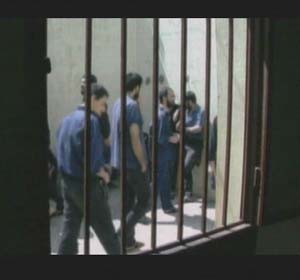
Prisoners were only allowed into the light once
a month
|
Hunger strikes about conditions were commonplace. A spell in
solitary was often the punishment.
These punishment cells were just concrete boxes less than a metre
wide apart from a tiny ventilation shaft at the top. They had no
toilets and only a few were big enough to lie down in. It wasn't
just hours or days that prisoners spent in these, many of them were
there for weeks even months in solitary and one detainee said he did
a seven month stretch.
How to survive when locked up for years in solitary confinement
between the four walls of a 1m 80 by 80 cell; or when six people
have to share a 2.25 by 2.25 m room.
Deprived of the most basic necessities, the prisoners recreated
them, picking up secretly and hiding bits of string, wood and stone,
cheese wrappers, olive stones, garbage. That is how they contrived
to produce secretly a neele, a pencil, strings of prayer beads made
of olive stones...
|
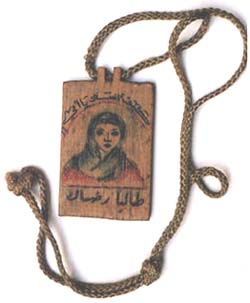
Prisoners secretly produced
works of art from garbage |
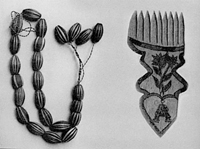
Prayer beads from olive stones
... a comb from drift wood |
The prisoners used their walls as canvases for expressing
themselves. In the women's section there is a drawing of a fish with
a heart attached to it and a painting of six white horses running
over a darkened field. There was a picture of Father Christmas taken
from a chocolate wrapper. And names.
"Zeina Koutash,
born 3/9/79, arrested 7/5/99, released 3/1/2000."
There were the names of Rana Awada and Ismahan Ali Khalil, only 19
when she was dragged to this awful place by the SLA.
"How many drops of blood have been spilt on our soil and have not
flowered?"
she wrote on the wall, along with two words.
"Remember me."
In the mens section, Abu Ahlan had written on his wall:
"Lebanon is ours and for our children after us."
School Teacher Tortured To Death
Nowhere, it seems, was beyond Khiam's reach. This head teacher of a
school was picked up in 1986.
|
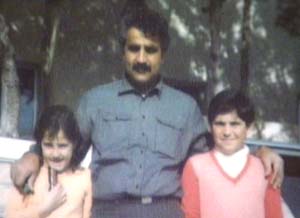
School Head Teacher Abdullah Hamzi, father of
three children, was tortured to death at Khiam
prison
|
Abdullah Hamzi had made no secret of his opposition to the Israeli
occupation. But his family insist he wasn't part of the guerrilla
campaign against Israel.
He left a wife and three children behind when he was taken away by
Israeli soldiers one February dawn. They had no idea what became of
him once he'd gone.
Feyrouz Hamzi:
"We went crazy, we lost our minds. We used to ask and ask and ask
and make enquiries; 'do you know where they've taken him?' We
couldn't find him. Some said they'd killed him, others said he was
still here, some said he was taken to Israel. Some said they'd put
him in a cell alone."
|

Feyrouz Hamzi, widow of murdered teacher
Abdullah Hamzi
|
What Feyrouz and her children didn't know is that she was already a
widow, they were already orphans. Abdullah Hamzi was killed within
three weeks of arriving in Khiam.
The events of that night unfolded in earshot of Ryadh Kalekesh's
cell. He recalls:
"He kept shouting; 'there are no charges against me, this is unjust
and unfair'. He banged on the door demanding to be released. Then
the guards took him out, handcuffed him, hung him on the pole and
beat him. When he died at their hands the guards started blaming
each other for the death of Abdullah Hamzi."
For three and a half years, oblivious of the truth, Feyrouz walked
the thirty miles to Khiam carrying clothes and food to the husband
she believed was being held there.
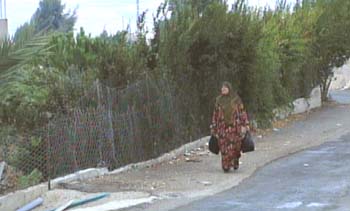
For three and a half years Feyrous walked the 30 miles
to bring food and cloths for her husband who, unknown
to her, was already dead |
She eventually learnt what had happened from detainees who were
released.
But even now this family's Khiam story isn't quite over.
Feyrouz Hamzi:
"We want his body so we can bury him. We want to know where he is.
We'll never give up our fight to bring him back. This is what we're
demanding, even if it costs us our lives, we want his body back."
Abdullah Hamzi died in the spring of 1986.
In 1989 two prisoners were killed during a protest - the guards
threw tear gas into their windowless cells.
Another three are believed to have lost their lives as a result of
torture. Two prisoners simply disappeared and altogether at least
fourteen people are believed to have died in this detention centre
or not long after leaving it. The full toll isn't known for certain.
Israel Defeated By Hizbullah
The final act unravelled faster than anyone could have anticipated.
In May 2000 Israeli troops scrambled out of southern Lebanon with
Hezbollah forces hard on their heels.

Israeli Army, defeated and humiliated by
Hizbullah, scramble out of Lebanon in the cover
of darkness |
Twenty-two years of occupation were over. Hezbollah and their allies
were victorious. Without Israeli support the SLA simply melted away.
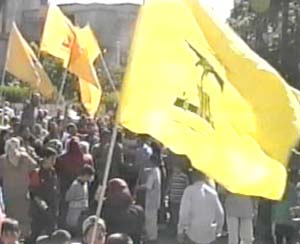
Hizbullah is victorious |
Crowds enter Khiam Prison and freed the prisoners
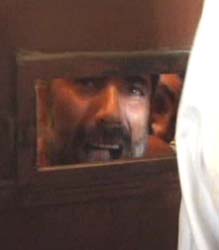
The first sight of freedom:
Cries of 'Allah O Akbar' - God is Greater |
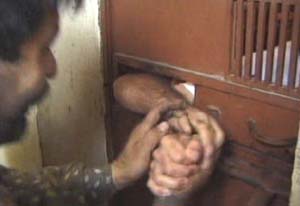
Prisoners being freed as the prison echos of
'Allah O Akbar' |
Free but its not over
One of those freed that final day was Ryadh Kalekesh:
"My mind was racing. A thousand thoughts went through my mind. I
felt fear and euphoria at the same time. I wanted to find the girl
who'd been faithful to me and was waiting for me."
As towns and villages all over southern Lebanon welcomed home their
local heroes, Ryadh Kalekesh had something more to celebrate.
He and Nada fell in love as teenagers. They got engaged just before
his detention and she waited for him throughout those fourteen years
and four months.
Nada recalls:
"Everyone was greeting him but I wasn't there. He was looking for
me. When we finally found each other I fainted. I woke up to hear
him saying; 'it's me, Ryadh, I'm here, wake up'. I looked at him and
my tears started running. He hugged me and put me in the car. This
was our meeting, it was a strange feeling."
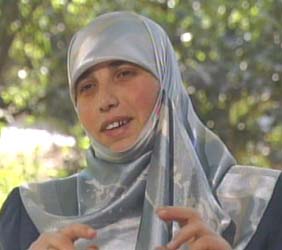
Nada engaged to Ryadh waited for 14 years
while he was imprisoned |
But the years Ryadh Kalekesh spent in Khiam have left their mark.
The electric shock torture did long term damage - he's had six
operations on his genitals over the past five months.
His doctor says almost all the long term detainees from Khiam he's
examined have eye problems because of the conditions they were kept
in.
Ali Kashmar suffers frequent panic attacks. His mother says he
desperately needs help he's not getting.
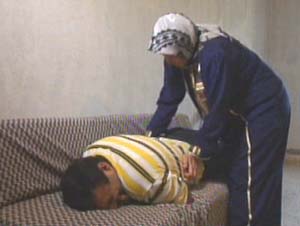
Ali Kashmar still suffers frequent panic attacks,
his mother attends him |
Ali Kashmar's mother confides:
"He feels anxiety. He asks me to sit by his side and says; 'I feel a
pressure in my body that wants to escape'. He remains like that all
day. Sometimes he spends three or four days or even a week asleep.
He does nothing but eat, go to the toilet and sleep. He slips into a
state of drowsiness."
Khiam is now a place of pilgrimage. At weekends hundreds of people
crowd through the buildings.
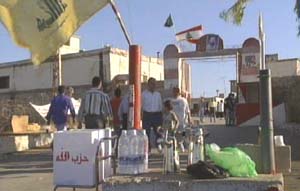
Entrance of Khiam Prison after liberation |
Their guides, who saw so much suffering here, want justice.
There are those who believe that for the sake of reconciliation
Khiam's story should be allowed to slip quietly into history,
especially at this sensitive moment in Middle East politics.
But there are also those for whom forgetting is not an option.
Ali Kashmar is still a prisoner of his memories. Ali is asked: When
you stand here and look at the prison what goes through your mind?
Ali Kashmar cannot reply, he shakes his head and walks away.
So what has become of those who are guilty of this crime?
The people of Israel have elected him, Sharon who led the brutal
invasion of Lebanon and is responsible for these war crimes, as
their Prime Minister. His lackeys the SLA torturers who escaped
Lebanon, today enjoy holiday apartments with Mediterranean views as
guests of the state of Israel.
References:
This article relies on the work of several journalists and reporters
for which we are grateful:
- Most of the interviews and images are taken from the BBC
Correspondent Series episode titled
"Israel Accused" which was
broadcast on 4th November 2000 (44 min). The reporter was Edward
Stourton.
- The description of the torture den came from Robert Fisk's article
"Inside a torturers' den, manacles lie abandoned" which appeared in
the Independent Newspaper on 25th May 2000.
- Part of the description of the prison cells came from
Hilary
Andersons BBC News report on Khiam Prison which was broadcast on May
27th 2000.
- Details of how the prisoners spent their time locked up deprived
of the most basic necessities, and the images of their artwork
originates from the introduction to the film Khiam by Joana
Hadjithomas and Khalil Joreige (Lebanon/2001/Video/52 min).



























































